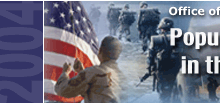


 |
 |
 |
|
|
ACTIVE COMPONENT ENLISTED APPLICANTS AND ACCESSIONS The Services are one of the largest employers in the United States, enlisting nearly 176,000 young men and women in the Active Components in FY 2004. Recruiting a quality force is as important as ever, perhaps more important, given the decreasing number of men and women in the military and the increasing sophistication of weapons and methods for fighting modern wars. Service missions have changed to include peacekeeping and humanitarian efforts, requiring additional skills from today's men and women in uniform. With an improving economy in 2004 as measured by unemployment rate, recruiters have experienced challenges to signing up new recruits. Although access to post-high school opportunities has expanded in recent years, research suggests that the Service recruiting campaigns are having an impact on the youth of our country. Among today’s youth, the military is perceived as providing opportunities, furthering education, helping individuals grow and mature, and contributing to the country. [Footnote 1] As an increasing proportion of youth have college aspirations today, the military finds recruiting qualified personnel competitive. Most high school students report that they plan to go to college (80 percent respond that they expect to complete a bachelor’s degree or higher degree and 91 percent respond that they will participate in post-secondary education). [Footnote 2] Nearly 64 percent of the graduates of the high school class of 2003 actually enrolled in college in the Fall after their senior year, compared to about half of high school graduates 20 years ago. [Footnote 3] By 2003, 57 percent of all 25- to 29-year-olds had completed some college and 28 percent had at least a bachelor’s degree. [Footnote 4] The desire to participate in post-secondary education is important to monitor, as propensity of college-bound youth is lower than for those not planning to attend college. [Footnote 5] Despite increasing competition with colleges and universities, the hard work of military recruiters and innovative incentive programs helped the Services meet their overall FY 2004 active enlisted accession requirements. Although the Navy and Marine Corps met their individual goals, the Army and Air Force fell short of their goals. Lower unemployment rates (Table 2.1) during FY 2004 may have contributed to recruiting challenges. [Footnote 6] Programs designed to attract college-bound youth, such as the Army's "College First" program that compensates recruits while they attend college during time in the Delayed Entry Program or in the Selected Reserve, helped the Services attract a high-quality accession cohort (high school graduates with above average aptitude) in FY 2004. [Footnote 7] This chapter introduces the Active Components enlistment process, followed by demographic characteristics of enlisted applicants and recruits.
[Footnote 1] Sellman, W.S., Reinventing DoD Corporate Marketing, briefing presented to the International Workshop on Military Recruitment and Retention in the 21st Century, The Hague, Netherlands, April 2001. [back to paragraph] [Footnote 2] U.S. Department of Education, The Condition of Education 2004 (NCES 2004-077) (Washington, DC: National Center for Education Statistics, 2004), Indicator 15. [back to paragraph] [Footnote 3] U.S. Department of Education, The Condition of Education 2005 (NCES 2005-094) (Washington, DC: National Center for Education Statistics, 2005), Table 20-1. [back to paragraph] [Footnote 4] U.S. Department of Education, The Condition of Education 2005 (NCES 2005-094) (Washington, DC: National Center for Education Statistics, 2005), Table 23-3. [back to paragraph] [Footnote 5] Kilburn, M.R., & Asch, B.J., Recruiting Youth in the College Market: Current Practices and Future Policy Options. (Santa Monica, CA: RAND, 2003). Segal, D.R., Bachman, J.G., Freedman-Doan, P., and O’Malley, P.M., "Propensity to Serve in the U.S. Military: Temporal Trends and Subgroup Differences," Armed Forces & Society, 25 (1999), pp. 407–427. [back to paragraph] [Footnote 6] Labor force statistics extracted from the Current Population Survey, Bureau of Labor Statistics. (Seasonally adjusted unemployment rate in the civilian labor force.) URL: http://www.dol.gov. [back to paragraph] [Footnote 7] Rutherford, G., Recruiting from the College-Oriented Market – information paper (Washington, DC: Office of the Assistant Secretary of Defense, July 6, 2001); Defense Manpower Data Center, Enlistment Supply in the 1990s: A Study of the Navy College Fund and Other Enlistment Incentive Programs (DMDC Report 2000-015) (Arlington, VA: Defense Manpower Data Center, 2001). [back to paragraph] Summary
| Contents | Search
| Download | Links
| FAQ | Home |
|||||||||||||||||||||||||||||||||||||||||||||||||||||||